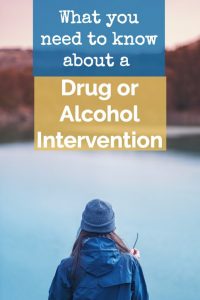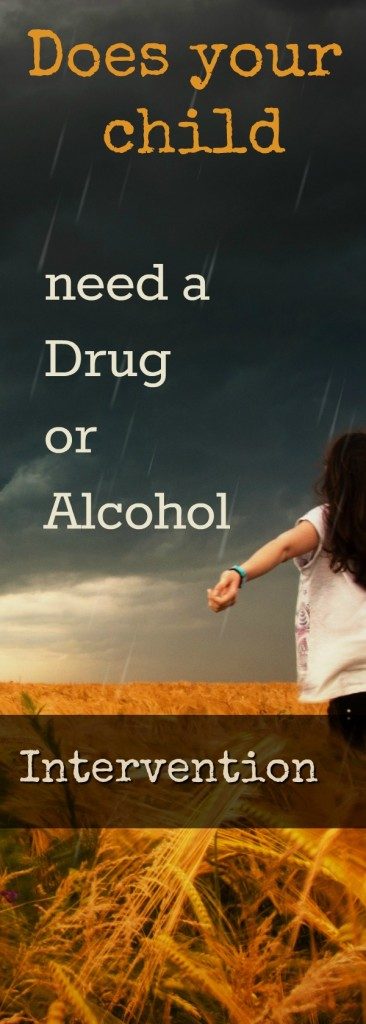Is my loved one a good candidate for a drug or alcohol intervention?
I have some good news. Substance abuse recovery treatment has advanced in the last couple of decades. It’s no longer true required that you have to hit “rock bottom” to get help. A planned drug intervention might possibly be the solution that will start a lifetime of recovery.
What is a Drug Intervention?
A drug intervention helps a person see the link between their alcohol or drug use and the problems in their life. In other words, it gets the person out of denial. The goal is for the addict (or alcoholic) to see that they need help.
This is not as easy as it sounds.
When a person is physically and mentally addicted to drugs they spend their entire day lying and justifying their behavior.
An intervention is not just a brief conversation. This is a serious, well-thought-out talk with a lot of advanced preparation. You are going to confront the person — and show concern over their drug or alcohol use. It should be supportive — free of anger or blame.

If absolutely necessary, interventions can be a one-on-one conversation, but it’s going to be more powerful, if all the people involved in the illness, are there.
You must stop blaming yourself!
- You didn’t cause the addiction.
- You can’t control the addiction.
- You can’t cure the addiction.
- You can’t stop drinking or using for another person.
There are five consistent myths about an intervention, according to the Association of Intervention Specialist
Myth Number One:
Overcoming addiction is a simply a matter of willpower. You can stop using drugs if you really want to.
Prolonged exposure to drugs alters the brain. These brain changes make it extremely difficult to quit by sheer force of will.
Myth Number Two:
Addiction is a disease; there’s nothing you can do about it.
Most experts agree that addiction is a brain disease, but that doesn’t mean you’re a helpless victim. Addiction can be treated and reversed through therapy, medication, exercise, and other treatments.
Myth Number Three:
Addicts have to hit rock bottom before they can get better.
The longer drug abuse continues, the stronger the addiction becomes and the harder it is to treat. Don’t wait to intervene until the addict has lost it all.
Myth Number Four:
You can’t force someone into treatment; they have to want help.
Treatment doesn’t have to be voluntary to be successful.
Myth Number Five:
Treatment didn’t work before, so there’s no point trying again.
Recovery from drug addiction is a long process that often involves setbacks. Relapse doesn’t mean that treatment has failed or that you’re a lost cause.
I’m overwhelmed – where do I start the Drug Intervention Process?
Do your research. First, you should get some background information about the disease. This will help you to understand what is going on with your loved one. You may even want to talk to a therapist or attend a support group to gain a better understanding of substance abuse.
Get people involved. Most commonly it is a group of 6-8. Children may be included if appropriate. Get out some paper and make a list of key family members, friends, co-workers, and employers to take part in the planning and intervention.
Strategize. Discuss barriers and difficulties that have been a problem in the past. Each person should write a letter to the person and read it during the intervention. This should focus on your love, care, and respect for the individual, as well as your concern and desire to help.
Practice. The group members should rehearse reading their letters to one another and edit them to remove anger, judgment, and blame. They should also decide the order in which the letters will be read, putting more sensitive readers in between stronger ones. There should be some bottom lines and “ultimatums”.
Intervention Day
Have each member speak. Following the rehearsed format for the meeting, everyone should go around and read his or her prepared statement. If a professional interventionist is involved, he or she can act as the leader of the meeting and call on people to speak.
Give each family member or friend the chance to say how the person’s actions have personally affected their lives, and how much they love the person and want things to get better.
State Consequences.
The impact of a drug intervention is its ability to create and present the “crisis” in the addicted person’s life to a point where the person chooses treatment. If the person chooses not to go to treatment, then there are usually some significant consequences that go into effect.

Enforce Consequences.
It might be painful, but the most loving thing — is to follow your plan. The very best thing you can do is cut off funding, break up with the person, or do whatever you personally know will create a significant life change that may help the person take a new path.
- If another crisis happens later, take advantage of it. For example, if the person ends up in jail or in the hospital, use that experience to show the person that he or she really does need treatment. Having a second intervention may be helpful.
- Remember, you are helping him or her to heal. Sometimes, we need to endure the pain of a loved one in order to provide the person with the help needed to get well.
Warning. Be very careful of the mental state of the person you are performing an intervention on. Intervention should only be performed on someone with a normal state of mind, for both the target individual’s safety and the safety of the people performing the intervention. Contact us or go to our intervention page if you want immediate confidential guidance.
More Drug Intervention Information Than You Need to Know
There are several different intervention approaches
The first one I found is called CRAFT.
It was defined on an HBO page that is dedicated to addition. Who knew?
“The CRAFT goals are to teach you how to encourage your substance user to reduce use and enter treatment. The other goal is to help you enhance your own quality of life. This non-confrontational approach teaches you how to figure out the best times and strategies to make small but powerful changes. And it will show you how to do so in a fashion that reduces relationship conflict.”
The second method is the Johnson Method
“The Johnson Model of Drug Intervention is a confrontational approach to drug and alcohol intervention that was introduced in the 1960s. Named after Vernon Johnson, often considered the father of intervention, it is based on his belief that denial is so pervasive in addicted individuals that they are only able to see the reality of their situation when presented with the crises it has caused in their life. An interventionist leads the family and close friends in this planned confrontation, which is unknown to the addicted individual beforehand.”
The third is the Family Systems Therapy
“Family systems therapy draws on systems thinking to view the family as an emotional unit. When applied to families, systems thinking—evaluating the parts of a system in relation to the whole—suggests that an individual’s behavior is informed by and inseparable from the functioning of his or her family of origin.”
There are more:
Animal-Assisted
ARISE Intervention Model
Confrontational Intervention Model
Love First Intervention Approach
Tough Love Intervention Approach
Final Thoughts on Interventions
I would love to hear from you if you have any questions or just want to talk to someone who has been in your shoes. Just call me on my cell phone 949-307-2880. It’s not a bother, there is no reason to be shy. I am looking forward to hearing from you.
SaveSave
SaveSave
SaveSave
SaveSave
